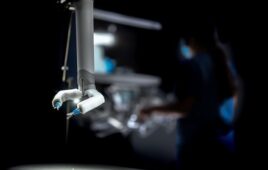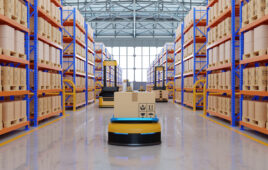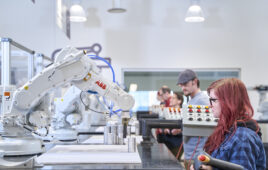When Parker Hannifin CEO Don Washkewicz challenged his team to explore the future of the company seven years ago, the team explored robotic devices, such as a robotic exoskeleton, for medical applications. Parker has key core competencies in motion and control technologies, and this led the team to look into wearable robotic devices in the prosthetics and orthotics space.
The Parker team connected with researchers at Vanderbilt University who wanted to adapt robotics technology to help patients with lower limb paralysis increase mobility and regain the ability to walk. This led to the development of a wearable exoskeleton that consists of a brace worn on the hips and legs, and is powered by motors, batteries, and other electronics.

In 2012, Parker Hannifin and Vanderbilt reached an agreement to license the technology and soon after the companies began working to commercialize a robotic exoskeleton called Indego. Dr. Ryan Farris was a co-inventor in the development of the technology as part of his doctoral work at Vanderbilt, and Parker Hannifin brought him on as the technical lead for the business unit tasked with bringing Indego to market.
Searching for a flexible material and manufacturing solution
Farris and his team had aggressive development deadlines to meet. But they found they spent a good deal of time waiting for production quotes and final parts through the company’s traditional manufacturing suppliers.
In a highly competitive marketplace, time is of a premium. This pursuit—to shorten design cycles and manufacture parts faster—led him to Protolabs for prototyping and end-use parts.
“We primarily use Protolabs to test new ideas,” Farris explained. “For instance, as we consider a potential design improvement, we want the ability to create parts and see how they perform as quickly as possible.”
One particular design that required quick-turn parts was related to a component that serves as a light pipe for the device. This part transmits light from a small LED on an embedded circuit board out to the exterior so the user can see the device’s current status.
“This little indicator is important because this is how the user—the paraplegic, the stroke patient, or whoever is using the system—knows what state they’re in, what mode they’re in, and what’s about to happen with the device,” said Farris.
The initial light pipe design was manufactured with a molded transparent thermoplastic. After several testing cycles, it became apparent the material was too brittle to hold up to the rigors of daily use, since the system was designed to flex with the user’s movement. Farris also explained the light pipe was a part of a larger assembly, and the relative motion of the assembly did not cooperate well with the rigid plastic-like component.
Rapid silicone rubber tooling bridges production gap
Farris and his team reevaluated the material used for the light pipe component and decided to manufacture the part with liquid silicone rubber (LSR). A molded LSR part would be able to naturally flex with the user’s motion and have the durability to last indefinitely. But the challenge was more than identifying the proper material. They also needed a cost-efficient molding option optimized for this stage of product development since design was not yet finalized.
The robotic exoskeleton was still in the prototyping phase and FDA approvals were still pending, so a costly investment in traditional tooling was not ideal. Farris turned to Protolabs’ LSR molding process to quickly manufacture several light pipe components so that he could test the new design and have the flexibility to iterate if necessary.
He notes that the key to accelerating the molding process was Protolabs’ automated, interactive quoting system. He and his team often upload parts for quotes in a few hours, then go through several iterations until a part is within their targeted cost.
Automated quoting saves development time
After receiving the molded LSR parts, the team put the new design through testing and found it had the flexibility and durability to withstand the daily use of the Indego system. Farris said. “The light transmission is excellent, the visibility of the indicator to the user is excellent, and we have not had any durability issues since the change.”
Farris estimates that Protolabs’ molding service saved his team between one and two months of time by manufacturing the LSR parts within days. With tooling optimized for low-volume production, they could bridge the gap between early prototypes and final production.
“Internally, if had we tried to make these parts ourselves, it would probably take a month due to bandwidth limitations,” said Farris.
But this redesign was much more than a product improvement developed in an R&D lab. It also enabled the team to implement customer suggested improvements quickly, improving customer service.
“Our aim is to be as fast as possible. When we have new developments, part of our competitive advantage is speed. When we have issues in the field, one of the things that we believe shows concern for our customers is our speed of response,” he explained.
In addition to the molded LSR part, the Indego engineers and designers relied heavily on Protolabs’ CNC machining and 3D printing capabilities throughout the development of the robotic exoskeleton. For example, Farris notes that he had fixtures machined to secure components in place for ultrasonic welding. He also used 3D printing to build nylon prototypes through selective laser sintering before moving to injection molding.
With an on-demand manufacturing option at its disposal, Parker Hannifin has been able to reduce development time, bring innovative products to market faster, and effectively respond to customer feedback. Overall, including molded production parts, Farris estimates Parker Hannifin’s Human Motion and Control business unit has manufactured thousands of components with Protolabs and will continue leveraging its digital manufacturing services in future generations of the Indego.
Proto Labs Inc.
www.protolabs.com
Filed Under: Robotics • robotic grippers • end effectors






Tell Us What You Think!